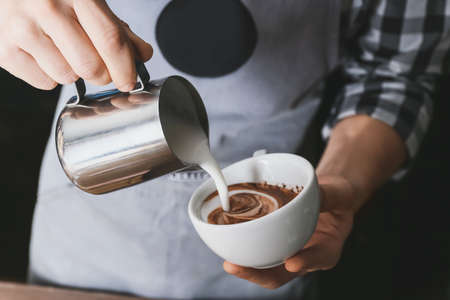1. The Origins of Coffee Ice Cream
Coffee ice cream has a story as rich and flavorful as the dessert itself. While its easy to assume that coffee and ice cream have always gone hand in hand, this delicious combination actually took time to become the fan favorite we know today in the United States.
The roots of coffee ice cream can be traced back to Europe in the 18th century, where frozen desserts were considered a luxury for the elite. Early versions of coffee-flavored frozen treats appeared in France and Italy, using brewed coffee or espresso mixed with cream and sugar. However, it wasn’t until much later that the flavor made its way into American freezers and hearts.
In the U.S., coffee ice cream began gaining popularity during the early 20th century, when ice cream manufacturing became more widespread and accessible. The American love affair with coffee was already well established by then, so it was only natural for coffee to make its way into frozen desserts. Over time, brands began experimenting with different roasts and blends to create the perfect balance of boldness and sweetness in their recipes.
Popularity Over Time
Here’s a quick look at how coffee ice cream grew in popularity across different decades:
| Decade | Milestone |
|---|---|
| 1920s | Coffee ice cream appears in soda fountains and diners, often served in sundaes. |
| 1950s | Mass production brings it to grocery store shelves as a specialty flavor. |
| 1980s | Premium ice cream brands like Häagen-Dazs and Ben & Jerry’s feature bold coffee flavors. |
| 2000s–Present | Artisan creameries experiment with single-origin coffee beans and cold brew infusions. |
A Beloved Flavor in American Dessert Culture
Today, coffee ice cream holds its own among classic favorites like vanilla, chocolate, and strawberry. Its seen as a sophisticated yet comforting flavor—perfect for those who enjoy a bit of caffeine kick with their sweet treat. Whether enjoyed on its own, paired with brownies, or swirled into milkshakes, coffee ice cream is now deeply embedded in American dessert culture.
2. Sourcing the Perfect Coffee Bean
When it comes to crafting the perfect scoop of coffee ice cream, everything starts with the bean. The quality, origin, and ethical sourcing of your coffee beans can make all the difference in flavor and overall experience. Let’s break down why choosing the right beans matters and how different regions bring something unique to your next favorite frozen treat.
The Role of Bean Quality
High-quality coffee beans are essential for achieving a rich, authentic coffee flavor in ice cream. Beans that are freshly roasted and free from defects provide cleaner, more vibrant notes. Lower-grade beans can taste bitter or flat, which doesn’t do justice to a creamy dessert like ice cream.
Regional Flavor Profiles
Coffee beans from different parts of the world carry distinct flavor characteristics based on their growing conditions—like soil, altitude, and climate. Here’s a quick look at some popular regions and what they typically offer:
| Region | Flavor Notes | Best Use in Ice Cream |
|---|---|---|
| Ethiopia | Floral, fruity, bright acidity | Great for light, aromatic coffee ice creams |
| Colombia | Balanced, nutty, mild citrus | Ideal for classic coffee flavors |
| Sumatra | Earthy, bold, low acidity | Perfect for deeper, more robust profiles |
| Guatemala | Chocolatey, spicy, full-bodied | A great match for mocha or chocolate swirl ice creams |
Sustainable and Ethical Sourcing Matters
Beyond flavor, how coffee is sourced plays an important role in creating a scoop you can feel good about. Supporting fair-trade and sustainably sourced coffee ensures farmers get fair wages and helps protect the environment. Many small-batch roasters across the U.S. now partner directly with farms to bring transparency and care into every cup—and scoop.
Tips for Choosing Beans for Ice Cream at Home:
- Look for single-origin beans for a clean, focused flavor.
- Select medium to dark roast for a richer profile that pairs well with dairy.
- Buy whole beans and grind fresh before brewing to extract maximum aroma and depth.
- If possible, choose beans labeled as fair-trade or organic for ethical sourcing.
The journey from bean to scoop begins long before the ice cream maker gets turned on. With thoughtfully chosen coffee beans, youre laying the foundation for a flavorful and meaningful dessert experience.

3. From Brew to Base: Infusing Flavor
When it comes to coffee ice cream, the magic starts long before the churn. It begins with how we brew the coffee and how we incorporate that bold flavor into a creamy, dreamy base. Let’s break down how real coffee is used to create that perfect scoop.
Choosing the Right Brew
The type of coffee brew you use can make or break your ice cream. You want a method that gives a strong, smooth flavor without being too bitter or overpowering. Here are some common brewing methods used in coffee ice cream making:
| Brew Method | Flavor Profile | Best For |
|---|---|---|
| Cold Brew | Low acidity, smooth, slightly sweet | Mild and creamy ice creams |
| Espresso | Bold, intense, rich crema | Strong coffee-forward flavors |
| French Press | Full-bodied, more oils and texture | Rustic or artisanal styles |
| Pourover (e.g., Chemex) | Crisp, clean, balanced | Lighter roasts and subtle blends |
The Art of Extraction
The extraction process—how much flavor you pull from the beans—plays a key role. Under-extracted coffee can taste sour and weak; over-extracted coffee might be bitter and harsh. The goal is balance. A medium-to-dark roast is often preferred for ice cream because it holds up well against the dairy base without getting lost.
Brew Strength Matters
You’ll typically want a stronger-than-usual brew for ice cream since the cream, sugar, and cold temperatures can dull the intensity of the coffee flavor. Think 1.5 to 2 times stronger than your morning cup.
Merging Coffee with Ice Cream Base
The next step is combining your brewed coffee with the ice cream base—usually made of milk, cream, egg yolks (for custard-style), and sugar. There are two main approaches:
- Coffee-Infused Cream: Steep ground coffee directly into warm milk or cream, then strain before churning. This gives a mellow yet deep flavor.
- Brewed Coffee Addition: Add espresso or cold brew straight into your chilled base. This gives a cleaner but more pronounced taste.
Taste Testing Is Key
No matter which method you choose, always taste your mix before churning. If its not strong enough, try reducing other liquids slightly or adding a shot of espresso.
The Balance of Bold and Creamy
Coffee has naturally bitter notes, so balancing it with sweetness and fat is essential. High-quality dairy helps smooth out any rough edges, while sugar levels should be adjusted carefully—too little and it tastes flat; too much and it overwhelms the coffee.
Tips for Perfect Harmony:
- Add a pinch of salt to enhance depth.
- A splash of vanilla can round out bitterness.
- A touch of brown sugar adds caramel-like undertones.
Nailing that perfect blend of bold coffee notes with velvety textures takes practice—but once you get it right, every spoonful will remind you why this combo is such a classic in American dessert culture.
4. Crafting the Ideal Texture and Sweetness
When it comes to coffee ice cream, getting the texture and sweetness just right is key to enhancing the flavor of the coffee itself. American artisan ice cream makers pay close attention to the ingredients they use—especially dairy and sugar—to create a balanced, creamy scoop that appeals to local tastes.
Dairy Choices That Complement Coffee
The richness of dairy can either elevate or overpower coffee’s complex notes. Most U.S. small-batch producers prefer a high butterfat content in their base, which gives the ice cream a smoother mouthfeel and helps carry the boldness of roasted coffee flavors.
| Dairy Type | Texture Effect | Flavor Impact |
|---|---|---|
| Whole Milk + Heavy Cream | Creamy and rich | Mildly enhances coffee flavor |
| Half-and-Half | Lighter texture | Softer coffee notes |
| Coconut Milk (non-dairy) | Smooth but lighter body | Adds subtle tropical hint |
Sugar Profiles and Sweetness Balance
Sugar does more than sweeten—it also affects how hard or soft your ice cream will be. American artisans often experiment with different types of sweeteners to strike a balance between sweetness and preserving the bitterness and depth of the coffee beans.
| Sugar Type | Taste Profile | Texture Contribution |
|---|---|---|
| Cane Sugar | Crisp, clean sweetness | Smooth, standard texture |
| Brown Sugar | Mellow with molasses notes | Softer, slightly chewy texture |
| Corn Syrup (used sparingly) | Mildly sweet | Adds softness and prevents crystallization |
Tuning for American Palates
Taste preferences in the U.S. lean toward creamy textures and balanced sweetness—not too bitter, not too sugary. That’s why many local producers take a “goldilocks” approach: using just enough fat and sugar to make the ice cream indulgent but still let the unique character of each coffee bean shine through. They may even adjust batch-to-batch depending on whether they’re using a fruity Ethiopian roast or a deep, chocolatey Sumatran blend.
A Few Tips from American Makers:
- Add a pinch of salt to round out sweetness and enhance flavor complexity.
- Brewed espresso is often preferred over instant powder for a fresher taste.
- A dash of vanilla extract can soften sharp edges in darker roasts.
The magic of crafting great coffee ice cream lies in finding harmony—the perfect mix of creaminess, sweetness, and bold coffee character that makes each bite memorable.
5. Coffee Ice Cream in American Culture
Coffee ice cream has long held a special place in American hearts—and freezers. From its early days as a diner dessert staple to its modern reinvention in artisanal scoop shops, this flavor has evolved alongside Americas changing tastes and coffee culture.
Classic Diner Favorite
Back in the 1950s and 60s, coffee ice cream was a go-to treat at diners across the country. Served in tall glass sundae cups or scooped into banana splits, it brought a grown-up twist to traditional ice cream offerings. Its creamy texture and rich, roasted flavor made it a favorite among adults looking for something beyond vanilla or chocolate.
Modern Revival in Scoop Shops
Today, coffee ice cream is experiencing a revival. Boutique ice cream parlors and local creameries are experimenting with single-origin beans, cold brew infusions, and even collaborations with local roasters. These modern twists cater to younger consumers who care about sourcing, sustainability, and bold flavors.
Examples of Coffee Ice Cream Evolution
| Era | Style | Popular Features |
|---|---|---|
| 1950s–1970s | Diner Classic | Smooth texture, light roast flavor, often served with pie or sundaes |
| 1980s–1990s | Mass Market Expansion | Big brands like Häagen-Dazs popularize richer versions with espresso notes |
| 2000s–Present | Craft & Artisanal | Single-origin beans, fair trade ingredients, cold brew infusions, dairy-free options |
Reflecting Changing Consumer Preferences
The rise of specialty coffee culture in the U.S.—think lattes, pour-overs, and nitro cold brews—has influenced how people expect their coffee-flavored treats to taste. Consumers now look for deeper flavor profiles, less sugar, and even functional benefits like caffeine content. As a result, brands are responding with innovative recipes that mirror these preferences.
Trending Additions in Today’s Coffee Ice Cream:
- Cold brew extract for smoother coffee flavor
- Dairy-free bases like coconut or oat milk
- Add-ins like chocolate-covered espresso beans or caramel swirls
Coffee ice cream isn’t just a dessert anymore—it’s part of an evolving cultural conversation about quality, experience, and personal taste. Whether enjoyed at a retro diner or a hip urban scoop shop, its journey from bean to scoop continues to reflect the American love for both coffee and creativity.


